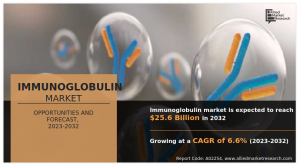PORTLAND, OR, UNITED STATES, January 6, 2025 /EINPresswire.com/ -- The global immunoglobulin market is experiencing significant growth, driven by the increasing prevalence of immune-related diseases and advancements in treatment technologies. As the market evolves, several key factors and trends are shaping its trajectory.
Market Overview
• Market Valuation: The immunoglobulin market was valued at $13.5 billion in 2022 and is projected to reach $25.6 billion by 2032, growing at a CAGR of 6.6% from 2023 to 2032.
• Key Diseases: The rise in conditions such as primary immunodeficiency (PID), myasthenia gravis, and Idiopathic Thrombocytopenic Purpura (ITP) are primary drivers of market growth, with approximately 8 million global PID cases and 36,000–60,000 U.S. cases of myasthenia gravis.
Application Insights
• Leading Applications: PID therapies dominated the market in 2022 and are expected to continue growing rapidly due to increased awareness and early diagnosis.
• Mode of Delivery:
• Intravenous Immunoglobulin (IVIG) remains the most widely used method due to its effectiveness.
• Subcutaneous delivery is gaining popularity thanks to technological advancements enabling at-home treatments.
Distribution Channels
• Hospital Pharmacies: The largest revenue source for immunoglobulin products.
• Retail Pharmacies: Anticipated to grow quickly due to the rise of outpatient care.
𝐆𝐞𝐭 𝐚 𝐒𝐚𝐦𝐩𝐥𝐞 𝐂𝐨𝐩𝐲 𝐨𝐟 𝐭𝐡𝐢𝐬 𝐑𝐞𝐩𝐨𝐫𝐭: https://www.alliedmarketresearch.com/request-sample/2586
Regional Insights
• North America: Holds the largest market share, attributed to advanced healthcare infrastructure and high disease prevalence.
• Asia-Pacific: Expected to grow at the highest CAGR, driven by a large population and increasing healthcare awareness.
Market Dynamics
Growth Drivers
• Innovative Production Techniques: Improvements in purification and manufacturing processes enhance efficiency.
• Supportive Policies: Reimbursement frameworks make therapies more accessible.
• Aging Population: Older adults are more susceptible to immune disorders, increasing demand.
Challenges
• Complex Manufacturing Processes: Intricate production can lead to supply chain disruptions.
• High Treatment Costs: Affordability remains a barrier for many patients.
Opportunities
• Increased investment in research and development.
• Growing focus on subcutaneous delivery technologies.
Recent Developments
• Product Launches: Grifols introduced a new 900-IU vial for rabies treatment (April 2020).
• Acquisitions: Grifols acquired Biotest to enhance its range of plasma-derived products (April 2022).
• Regulatory Approvals: Pfizer’s PANZYGA received FDA approval for treating chronic inflammatory demyelinating polyneuropathy (CIDP) (February 2021).
Future Outlook
The immunoglobulin market is set for robust growth due to ongoing advancements in therapies, heightened awareness among healthcare providers, and expanding opportunities across various regions. Strategic investments aimed at reducing production costs and enhancing patient outreach will be crucial in meeting the rising global demand for immunoglobulin therapies.
Summary at a Glance
• Market Size (2022): $13.5 billion
• Projected Size (2032): $25.6 billion
• CAGR (2023–2032): 6.6%
• Key Drivers: Rising prevalence of immune-related diseases, aging population, technological advancements.
• Challenges: High costs and complex manufacturing processes.
By addressing these challenges and leveraging opportunities for growth, the immunoglobulin market can significantly improve healthcare outcomes globally.
𝐄𝐧𝐪𝐮𝐢𝐫𝐞 𝐁𝐞𝐟𝐨𝐫𝐞 𝐁𝐮𝐲𝐢𝐧𝐠: https://www.alliedmarketresearch.com/purchase-enquiry/2586
Market Overview
• Market Valuation: The immunoglobulin market was valued at $13.5 billion in 2022 and is projected to reach $25.6 billion by 2032, growing at a CAGR of 6.6% from 2023 to 2032.
• Key Diseases: The rise in conditions such as primary immunodeficiency (PID), myasthenia gravis, and Idiopathic Thrombocytopenic Purpura (ITP) are primary drivers of market growth, with approximately 8 million global PID cases and 36,000–60,000 U.S. cases of myasthenia gravis.
Application Insights
• Leading Applications: PID therapies dominated the market in 2022 and are expected to continue growing rapidly due to increased awareness and early diagnosis.
• Mode of Delivery:
• Intravenous Immunoglobulin (IVIG) remains the most widely used method due to its effectiveness.
• Subcutaneous delivery is gaining popularity thanks to technological advancements enabling at-home treatments.
Distribution Channels
• Hospital Pharmacies: The largest revenue source for immunoglobulin products.
• Retail Pharmacies: Anticipated to grow quickly due to the rise of outpatient care.
𝐆𝐞𝐭 𝐚 𝐒𝐚𝐦𝐩𝐥𝐞 𝐂𝐨𝐩𝐲 𝐨𝐟 𝐭𝐡𝐢𝐬 𝐑𝐞𝐩𝐨𝐫𝐭: https://www.alliedmarketresearch.com/request-sample/2586
Regional Insights
• North America: Holds the largest market share, attributed to advanced healthcare infrastructure and high disease prevalence.
• Asia-Pacific: Expected to grow at the highest CAGR, driven by a large population and increasing healthcare awareness.
Market Dynamics
Growth Drivers
• Innovative Production Techniques: Improvements in purification and manufacturing processes enhance efficiency.
• Supportive Policies: Reimbursement frameworks make therapies more accessible.
• Aging Population: Older adults are more susceptible to immune disorders, increasing demand.
Challenges
• Complex Manufacturing Processes: Intricate production can lead to supply chain disruptions.
• High Treatment Costs: Affordability remains a barrier for many patients.
Opportunities
• Increased investment in research and development.
• Growing focus on subcutaneous delivery technologies.
Recent Developments
• Product Launches: Grifols introduced a new 900-IU vial for rabies treatment (April 2020).
• Acquisitions: Grifols acquired Biotest to enhance its range of plasma-derived products (April 2022).
• Regulatory Approvals: Pfizer’s PANZYGA received FDA approval for treating chronic inflammatory demyelinating polyneuropathy (CIDP) (February 2021).
Future Outlook
The immunoglobulin market is set for robust growth due to ongoing advancements in therapies, heightened awareness among healthcare providers, and expanding opportunities across various regions. Strategic investments aimed at reducing production costs and enhancing patient outreach will be crucial in meeting the rising global demand for immunoglobulin therapies.
Summary at a Glance
• Market Size (2022): $13.5 billion
• Projected Size (2032): $25.6 billion
• CAGR (2023–2032): 6.6%
• Key Drivers: Rising prevalence of immune-related diseases, aging population, technological advancements.
• Challenges: High costs and complex manufacturing processes.
By addressing these challenges and leveraging opportunities for growth, the immunoglobulin market can significantly improve healthcare outcomes globally.
𝐄𝐧𝐪𝐮𝐢𝐫𝐞 𝐁𝐞𝐟𝐨𝐫𝐞 𝐁𝐮𝐲𝐢𝐧𝐠: https://www.alliedmarketresearch.com/purchase-enquiry/2586
David Correa
Allied Market Research
+1 800-792-5285
email us here
Visit us on social media:
Facebook
X
Legal Disclaimer:
EIN Presswire provides this news content "as is" without warranty of any kind. We do not accept any responsibility or liability for the accuracy, content, images, videos, licenses, completeness, legality, or reliability of the information contained in this article. If you have any complaints or copyright issues related to this article, kindly contact the author above.


